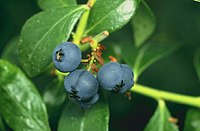
Photo from wikipedia
This study was performed to evaluate and compare the in vitro antioxidant, antimicrobial, and antimutagenic activities, and the polyphenolic content of the Nord-West Romanian wild bilberry (Vaccinium myrtillus L.) and… Click to show full abstract
This study was performed to evaluate and compare the in vitro antioxidant, antimicrobial, and antimutagenic activities, and the polyphenolic content of the Nord-West Romanian wild bilberry (Vaccinium myrtillus L.) and lingonberry (Vaccinium vitis-idaea L.) leaves from three different natural habitats (Smida, Turda, Borsa). In the case of both species, the flavanols level was higher in Smida habitat (altitude 1100 m), whereas quercetin derivates were more abundant in Borsa habitat (altitude 850 m). The bilberry leaf extracts contained in the highest amounts the feruloylquinic acid (59.65 ± 0.44 mg/g for Borsa habitat) and rutin (49.83 ± 0.63 mg/g for Borsa habitat), and showed relevant 2,2-diphenyl-1-picrylhydrazyl (DPPH) antioxidant activity (271.65 mM Trolox/100 g plant material for Borsa habitat, 262.77 mM Trolox/100 g plant material for Smida habitat, and 320.83 mM Trolox/100 g plant material for Turda habitat), for all the three extracts. Gallocatechin was the dominant flavanol in lingonberry species, with the highest amount being registered for Smida habitat (46.81 ± 0.3 mg/g), revealing a DPPH antioxidant activity of 251.49 mM Trolox/100 g plant material. The results obtained in the antimicrobial tests showed that the best inhibitory effect among bilberry species was attributed to the Turda (altitude 436 m) and Smida locations, against both Gram-positive and Gram-negative bacterial strains. For lingonberry, the differences in habitat did not influence the antibacterial effect, but the antifungal effect, only in the case of Candida zeylanoides. A strong antimutagenic effect was registered by the bilberry leaves toward Salmonella typhimurium TA100. Our study may be able to provide a better understanding of the correlation between natural habitat conditions and the accumulation of secondary metabolites and their related bioactivities in studied leaves.
Journal Title: Antioxidants
Year Published: 2020
Link to full text (if available)
Share on Social Media: Sign Up to like & get
recommendations!